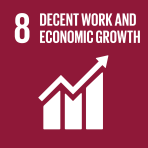- Home
- Sustainable Development Goals
- Decent Work and Economic Growth
 Decent Work and Economic Growth
Decent Work and Economic Growth
Global governance and System-wide coordination
The progress made in implementing the Youth Strategy across the UN System is largely attributed to the strategic guidance of the Youth2030 High-level Steering Committee (HLSC). This intergenerational committee leverages the expertise of UN leadership alongside insights and solutions from youth networks. Technical leadership from the Joint Working Group (JWG) and the focused efforts of time-bound and issue-specific Task Teams have also played pivotal roles.
Executive Summary
The fourth edition of the Youth2030 Progress Report provides an overview of the implementation of the Youth Strategy across the United Nations (UN) system. The report is being launched against the backdrop of emerging opportunities for meaningful youth engagement in policymaking and decision-making processes including at the UN but also marked by multiple global crises that have led to the Sustainable Development Goals being severely off track.
Architecture and capacities to deliver on Youth2030
Meaningful youth engagement in the UN System
Foreword
The world stands at a crossroads facing existential threats that transcend borders and generations – from conflicts to climate chaos to deepening inequalities.
UN System: Advancing global commitments on youth
Youth2030: Progress Report 2024
Youth2030: Progress Report 2024 represents a significant milestone marking six years since the launch of Youth2030 the UN Youth Strategy. The current report offers a comprehensive overview of the progress in implementation of Youth2030. By comparing baseline data from UNCTs (2020) and UN entities (2021) with the latest reported data in 2023 the report shows the strides made by the UN system in advancing global youth commitments and youth focus in UN strategic planning processes.
Way forward
The Youth2030 Progress Report 2024 provides important insights on the work of the UN with and for youth at various levels detailing progress strengths and gaps of UN entities and UNCTs in implementing the Youth Strategy.
Focus on youth in UN strategic planning processes
Conclusion and recommendations
Chapter VII consolidates the primary insights gleaned from the preceding discussions and present actionable recommendations tailored for member states and the international community. The overarching goal of this section is to equip stakeholders with concrete steps to ensure that data are effectively leveraged as a pivotal instrument for realizing the objectives of the 2030 Sustainable Development Agenda.
Data governance
This section delves into the intricate nature of data governance underscoring the importance of the social contract in harnessing data’s value in a fair and mutually advantageous way. The section offers an overview of three national paradigms concerning data governance. The section reflects on the consequences of such varied approaches emphasizing the importance and urgency of establishing universally accepted guidelines for data governance. The section concludes by presenting seven global data governance principles for development.
Understanding the multifaceted nature of data
This section delves into the intricate nature of data. It emphasizes data as products of technological economic and socio-cultural processes reflecting the biases and choices of creators. The role of technology including broadband networks Internet of Things (IoT) devices and mobile phones is highlighted in expanding data’s reach. Data are framed as a context-dependent resource shaped by the systems within which they exist underscoring the importance of governance that considers the interplay between technology data economic and socio-cultural dynamics for sustainable development.
Promises of data for development
Section III provides an overview of how nations can leverage data to achieve the SDGs. This section introduces two perspectives on data that shape the narrative of the subsequent sections. The first perspective views data as an economic input. Data serve as a driving force for development generating economic value and creating new market opportunities. The roles of digital platforms in global entrepreneurship and international trade are discussed in this context. The second perspective sees data as a crucial tool for decision-making offering robust evidence to support effective policies and strategies. This includes its role in improving health and welfare as well as in combating environmental degradation and climate change and advancing scientific research.
Introduction
At a time when digital connectivity defines our lives the importance of data in shaping the trajectory of global development cannot be understated. As economies and societies become increasingly interwoven with digital technologies data emerge not only as an asset but as a catalyst for transformative change. While data-driven insights harbour the potential to spur innovations and foster sustainable development the pathway is riddled with both unparalleled prospects and formidable challenges.
